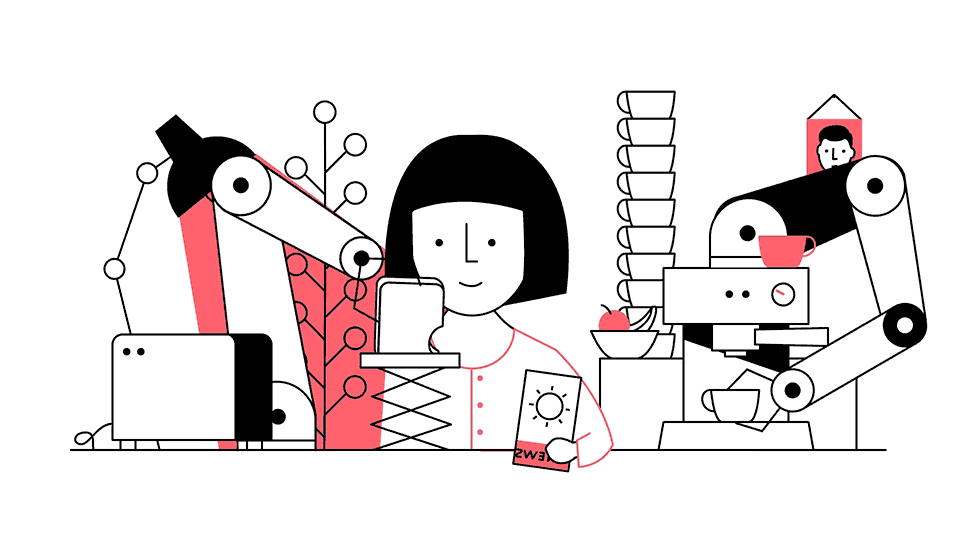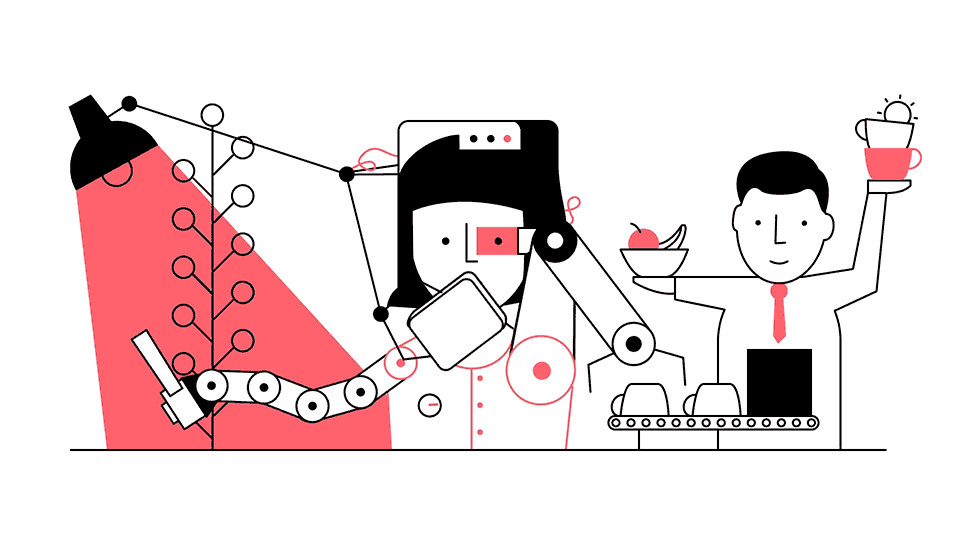Andrea Wiegelmann • 21.03.2018
Your new
house-mate
Robots, just like intelligent control systems, are now an indispensable component of our everyday lives. While we naturally use them, we shy away from defining this relationship. We should fill this vacuum if we want to actively create our future with the machines.
In the science fiction film Blade Runner by the US director Ridley Scott released in 1982 the humanoid robot Roy (described in the film as a «replicant») saved the life of the main character Deckhard, played by Harrison Ford, in view of this own «death», although Roy initially wanted to kill Deckhard. In Blade Runner the robots that look deceptively similar to humans have a memory enabling them to remember and query their own actions. They have the ability to learn and have similar behavioural patterns to humans. The robots in the film belong to the all-powerful Tyrell Corporation, a hightech conglomerate, which has specialised in the manufacture and management of its androids.
The scene that has been described poses the central question that accompanies the action from the start: What makes us humans into people and what distinguishes us from the devices, precisely when they start to become similar to us and we build up emotional relationships with them? While the question might still have sounded a long way off in 1982 – although it had repeatedly been the subject in literature and film – we are now coming across humanoid robots directly in the household and to provide care. Our relationship to them is ambivalent and we are very sceptical about their use.
The interesting thing in this is that our unease about the option of living with a robot has nothing to do with the latter’s technical infrastructure, which might be the actual alarming aspect, for example when considering the assessment and use of our personal data. However, whether it’s a Smartphone, control systems in buildings or soft bots that give us shopping tips, we are willing to use artificial intelligence. Thanks to «Alexa», «Google Home» & Co., intelligent systems also moved into our private sphere a long time ago. The step towards personal robots should therefore not be a major one.
Nevertheless, as soon as a computer-driven device is given a shape, which makes it appear as a «counterpart», we react emotionally. However, recently this is also happening to us with our laptop, when it falls down again or with a Smartphone, when it doesn’t open the app, which one needs urgently at that precise moment. What does this diffuse unease consist of? The future researcher and cyber punk author Bruce Sterling states on this subject that the term robot was coined by the Czech author Karel Čapek. Čapek wrote a play in 1920, in which robot-like workers (Czech «robota», which means a forced labourer) wipe out humans. The paranoid fear that the machine might turn against us apparently always resonates in our dealings with robots. In Blade Runner the «replicants» have a lifespan of four years so that they do not become a danger to humans. The question about «good or bad» explains our ambivalent relationship to the devices.
A machine, your personal assistant
This becomes understandable when a machine can act as a replacement for human contact or interaction, for example like «Alice». «Alice» has a pretty doll-like face and looks a bit like an enlarged female Playmobil figure. However, the robot is not a toy, it supports its older house-mates in their everyday lives, watches TV with them and makes sure they have taken their tablets each morning. The documentation from 2015 Alice Cares (Ik ben Alice) by the director Sandra Bruger shows how independent older women interact and become more active through the use of the emotionally intelligent robot in their everyday lives. Care from a human would certainly be more desirable, but what will happen if there are no longer enough of us to make this happen?
While we in central Europe are still at the start of this development, the use of humanoid robots in providing care at home or in hospital is part of everyday life in Japan. The fact that the enthusiasm for technology of the Japanese has encouraged this development, should in no way hide the fact that they are also a real necessity. Already in 2030, a third of the Japanese population will be over the age of 64. It doesn’t look any better in Europe: Of the 20 countries with the highest proportion of over 64 year-olds in the total population worldwide, all of them apart from Japan belong to the European Union. It’s easy to calculate that the number of elderly people living alone and requiring care and also those that are ill will soon far exceed the number of possible carers.
Today there are two different types of robot involved in providing care: Those that make the everyday lives of the care staff easier, transport patients or support care workers in doing everyday tasks. The «Care Assist Robot» is such a service robot, which is reminiscent of the devices from manufacturing industry, also «Hospi». Just like with «Alice», other designs count on our empathy. For example, the robot «Paro» used for therapeutic purposes, which is based on a young harp seal. Its development is founded on the good experience in animal-based treatment. There is evidence of the positive effect on mental and physical dexterity of the elderly with «Paro» and it is now being used in 30 countries, including in Germany.
There are also models for private households such as «Zenebo» or «Pepper». The latter is programmed in such a way that it can speak 20 languages, recognises our emotions through mimicry and voice and can react accordingly. Will we in future therefore cuddle and argue with our robots although we know they are machines?
In all the examples described the machine or at least the artificial nature of the robot can be experienced. This is also because we find a design similar to a human rather sinister. This phenomenon was already described in 1970 by the Japanese roboticist Masahiro Mori as «Uncanny Valley».[3] At the same time we assign human-like qualities to robots that are a designed in an appealing way and in the final analysis it’s this attribution, which characterises our relationship to them.
Your friend and helper?
This topic is also the subject of the comedy Robot&Frank, which was written in 2012 by Jake Schreier and takes place in the «near future» and is strikingly hardly any different from today. The film recounts the ambivalent relationship between the former jewellery thief Frank, who is starting to suffer from dementia, and his robot carer. The machine takes over after Frank initially refuses to allow it to play the role of a good friend.
Robots, as the film shows once again, are also accepted by us despite all our concerns. However, does this mean that we trust them? Do we let them decide for us: what we eat, what we wear, what medication we take? And continuing along these lines, if we let them carry out actions for us or make decisions and delegate tasks to them, are the machines then not also responsible for mistakes? Should they then not be programmed in such a way that they can learn and are in a position to develop further like Roy in Blade Runner? And when has the point been reached where one would also have to take note of them as a being?
We need to deal with these questions. The «near future» is on our doorstep and we should fashion it. Fitted with artificial intelligence, digital assistants for our private sphere and for commercial use are the trend in the technology industry. Another trend is intelligent prosthetics and implants in our body. What Ridley Scott highlighted in Blade Runner as a dystopian future scenario, is increasingly becoming reality. The borders between people and machines are becoming increasingly blurred.
New developments and products generally originate from major technology groups. Their artificial intelligence collects data about us, our habits, our behaviour. Google, Amazon & Co. can assess and use this data – and they do this, today and even more so in the future. The borders between care, support and monitoring are in flux. It is therefore not a question of whether we need robots – because they have been an unavoidable part of our everyday life for a while – but how we define our relationship to them and the organisations and infrastructures behind them.
Illustrations: Josh Schaub

